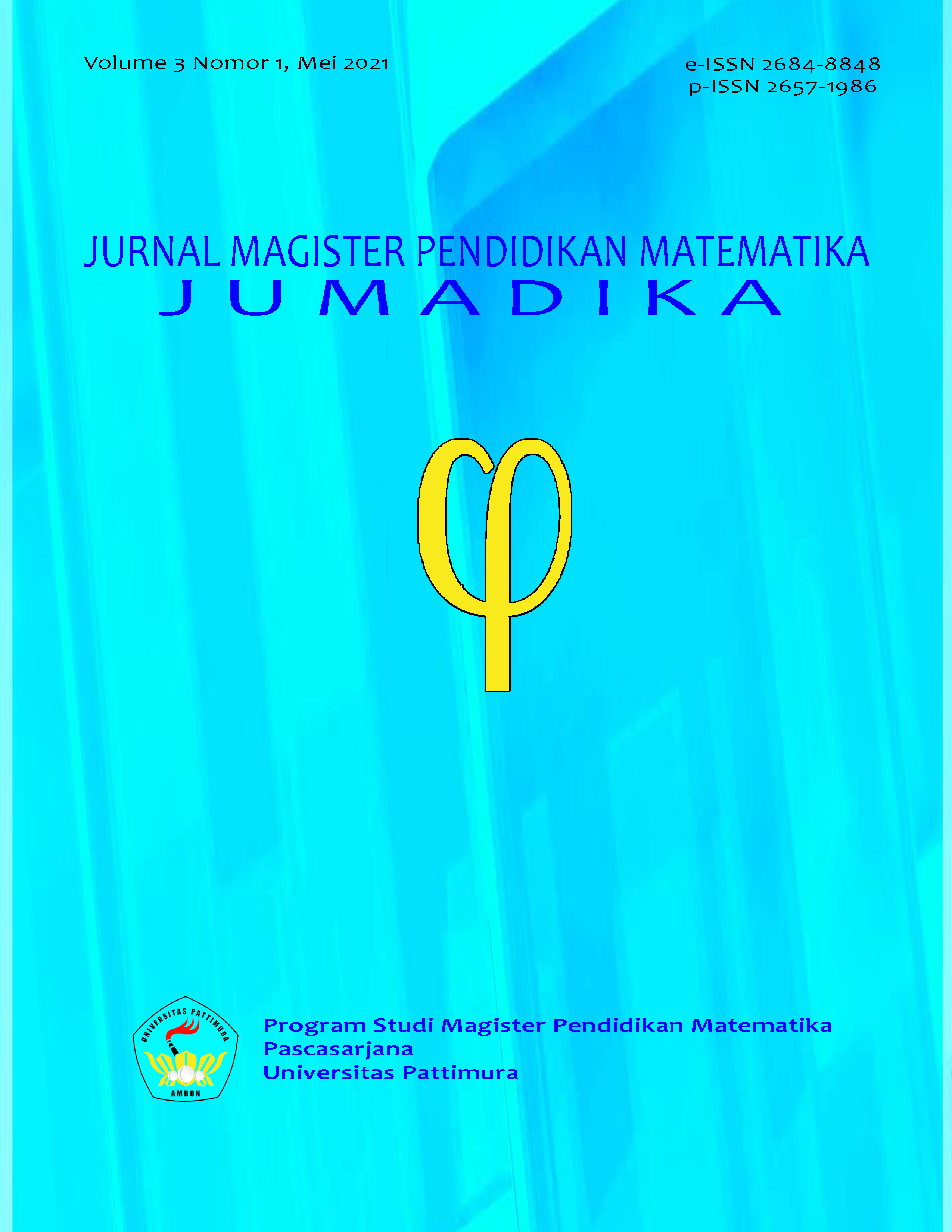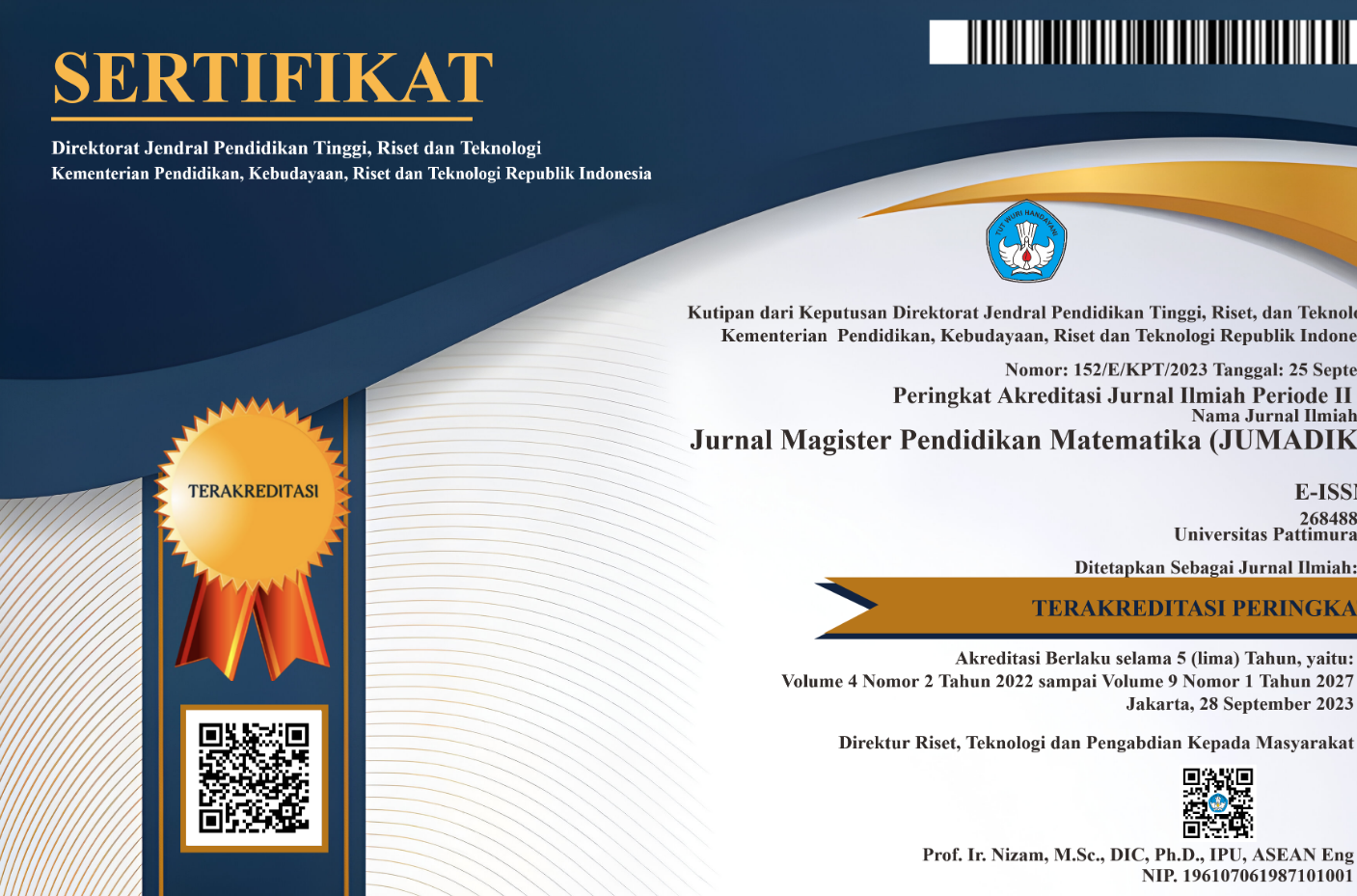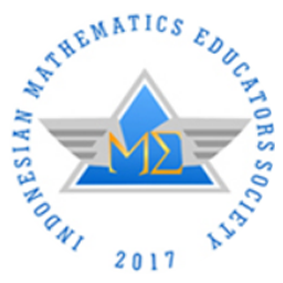REPRESENTASI MATEMATIS SISWA SMP KELAS 8 DAN SISWA SMA KELAS 10 DALAM MENGERJAKAN SOAL CERITA
Abstract
Representasi merupakan salah satu kemampuan yang penting untuk dikuasai oleh siswa, karena kemampuan representasi matematis adalah alat untuk berfikir bagi siswa untuk memahami masalah. Representasi merujuk baik kepada produk maupun kepada proses—representasi matematis sebagai produk adalah objek yang mewakili suatu hal, sedangkan representasi matematis sebagai proses adalah ketrampilan siswa untuk menangkap konsep atau hubungan matematis dalam beberapa bentuk yang menggambarkan interpretasi pemikiran siswa terhadap suatu masalah yang digunakan untuk menemukan solusi suatu masalah. Menurut hasil analisis penulis, terdapat perbedaan dalam hal pemilihan dan penggunaan representasi oleh siswa kelas 8 (KS 3) dan siswa kelas 10 (KS 4). Siswa kelas 8 lebih cenderung menggunakan representasi gambar dan representasi tersebut digunakan untuk merekam/menuliskan ide yang diperolehnya dari masalah yang diberikan, namun belum dioptimalkan penggunaannya sebagai alat bantu menemukan solusi. Sedangkan siswa kelas 10 lebih memilih mengoptimalkan representasi internal untuk memvisualisasikan situasi yang diperoleh dari masalah, kemudian menuliskan prosesnya memecahkan masalah secara sistematis, menggunakan representasi tertulis konvensional berupa variabel-variabel.
Downloads
References
Akita, M., & Saito, N. (2014). A Study on Role of Relational Representation on Creativity in Mathematics Education. In S. Oesterle, C. Nicol, P. Liljedahl, & D. Allan (Eds.), Proceedings of the Joint Meeting of PME 38 and PME-NA 36. PME. https://eds-a-ebscohost-com.proxy.lib.uiowa.edu/ehost/detail/detail?vid=12&sid=1f3c5639-f2b2-43ae-ace4-2e5916321020%40sessionmgr4007&bdata=#AN=118476592&db=eue%0Ahttps://dspace.uevora.pt/rdpc/bitstream/10174/13639/1/PMENA 36 PME 38 2014 Proceedings Vol 6.
Albert A. Cuoco. (2001). Preface. In A. A. Cuoco & F. Corcio (Eds.), The Roles of Representation in School Mathematics 2001 Yearbook (p. x). The National Council of Mathematics.
Chen, M. J., Lee, C. Y., & Hsu, W. C. (2015). Influence of mathematical representation and mathematics self-efficacy on the learning effectiveness of fifth graders in pattern reasoning. International Journal of Learning, Teaching and Educational Research, 13(1), 1–16. https://www.ijlter.org/index.php/ijlter/article/view/277/184
Diezmann, C. M., & English, L. D. (2001). Promoting the Use of Diagrams as Tools for Thinking. In A. A. Cuoco & F. Corcio (Eds.), The Roles of Representation in School Mathematics 2001 Yearbook (pp. 78, 84). The National Council of Mathematics.
Duval, R. (2006). A cognitive analysis of problems of comprehension in a learning of mathematics. Educational Studies in Mathematics, 61(1–2), 103–131. https://doi.org/10.1007/s10649-006-0400-z
Godino, J., & Font, V. (2010). The Theory of Representations as Viewed from the Onto-semiotic Approach to Mathematics Education. Mediterranean Journal for Research in Mathematics Education, 9(1), 189–210.
Goldin, G. (1998). Representations and the Psychology of Mathematics Education: Part II. Journal of Mathematical Behaviour, 17(2), 209–219.
Güler, G., & Çiltaş, A. (2011). The visual representation usage levels of mathematics teachers and students in solving verbal problems. International Journal of Humanities and Social Science, 1(11), 145–154. http://www.ijhssnet.com/journal/index/349:vol-1-no-11-si--august-2011abstract17&catid=16:journal-abstract
Kawazoe, M., Okamoto, M., & Takahashi, T. (2014). Students’ Mental Representations of Geometric Vectors and Sets Related to Linear Algebra.pdf. Proceeding of the 38th Conference of the International Group for the Psychology of Mathematics Education and the 36th Conference of the Noerth American Chapter of the Psychology of Mathematics Education (Vol. 6).
Lesh, R., Doerr, H. M., Carmona, G., & Hjalmarson, M. (2003). Beyond Constructivism. Mathematical Thinking and Learning, 5(2–3), 211–233. https://doi.org/10.1080/10986065.2003.9680000
Ni’mah, K., Purwanto, Irawan, E. B., & Hidayanto, E. (2011). Kesalahan Siswa dalam Membuat Generalisasi Pola melalui Representasi. Prosiding Seminar Nasional Matematika Dan Pembelajarannya, 479–484.
Sabirin, M. (2014). Representasi Dalam Pembelajaran Matematika. Jurnal Pendidikan Matematika, 1(2), 33–44.
Syafrudin, T., & Muksar, M. (2016). Kemampuan Representasi Matematis Siswa pada Materi Perbandingan. Prosiding Seminar Nasional Matematika Dan Pembelajarannya, 938–946.
The National Council of Teachers of Mathematics. (2000). Principle and Standards for School Mathematics. Key Curriculum Press. http://www.ghbook.ir/index.php?name=مجموعه مقالات دومین هم اندیشی سراسری رسانه تلویزیون Ùˆ سکولاریسم&option=com_dbook&task=readonline&book_id=13629&page=108&chkhashk=03C706812F&Itemid=218〈=fa&tmpl=component
Uwingabire, I., & Takuya, B. (2014). Multiple Representations Used by Rwandan Primary Teachers in Mathematics Lessons. Proceeding of the 38th Conference of the International Group for the Psychology of Mathematics Education and the 36th Conference of the Noerth American Chapter of the Psychology of Mathematics Education (Vol. 6), 254.
Velez, I., & Ponte, J. P. (2014). Promoting the understanding of representations by third grade students. Proceeding of the 38th Conference of the International Group for the Psychology of Mathematics Education and the 36th Conference of the North American Chapter of the Psychology of Mathematics Education (Vol 6).
Zhe, L. (2012). Survey of Primary Students’ Mathematical Representation Status and Study on the Teaching Model of Mathematical Representation. Journal of Mathematics Education, 5(1), 63–76.
Copyright (c) 2021 Varetha Lisarani, Abd. Qohar, Mr.

This work is licensed under a Creative Commons Attribution-NonCommercial-ShareAlike 4.0 International License.
License and Copyright Agreement
In submitting the manuscript to the journal, the authors certify that:
- They are authorized by their co-authors to enter into these arrangements.
- The work described has not been formally published before, except in the form of an abstract or as part of a published lecture, review, thesis, or overlay journal. Please also carefully read Jurnal Magister Pendidikan Matematika (JUMADIKA) Posting Your Article Policy.
- That it is not under consideration for publication elsewhere,
- That its publication has been approved by all the author(s) and by the responsible authorities – tacitly or explicitly – of the institutes where the work has been carried out.
- They secure the right to reproduce any material that has already been published or copyrighted elsewhere.
- They agree to the following license and copyright agreement.
Copyright
Authors who publish with Jurnal Magister Pendidikan Matematika (JUMADIKA) agree to the following terms:
- Authors retain copyright and grant the journal right of first publication with the work simultaneously licensed under a Creative Commons Attribution-NonCommercial-ShareAlike 4.0 International License (http://creativecommons.org/licenses/by-nc-sa/4.0/) that allows others to share the work with an acknowledgment of the work's authorship and initial publication in this journal.
- Authors are able to enter into separate, additional contractual arrangements for the non-exclusive distribution of the journal's published version of the work (e.g., post it to an institutional repository or publish it in a book), with an acknowledgment of its initial publication in this journal.
- Authors are permitted and encouraged to post their work online (e.g., in institutional repositories or on their website) prior to and during the submission process, as it can lead to productive exchanges, as well as earlier and greater citation of published work.








